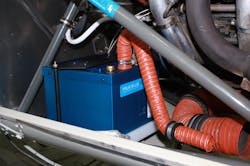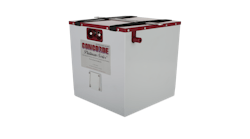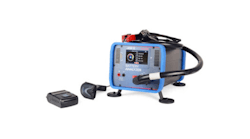Safe Design and Handling of Lithium-ion Batteries in Aircraft
Lithium-ion batteries have become the preferred source of electrical power for numerous consumer products that we use each and every day. I’d guess most of us have one in our pocket right now – that would be your cell phone.
Lithium-ion batteries have been a significant part of aviation for the past decade. Applications have been used in systems such as avionics backup power supplies, emergency lighting, ELTs, powering auxiliary equipment (crew cabin phones, cabin doors), uninterrupted power systems (UPS), and engine start batteries for fighter jets and drones.
Lithium-ion technology has made its way into engine-start batteries for general, business and air transport category aircraft. This technology has further evolved and FAA Supplemental Type Certificate (STC) installations for lithium-ion engine-start batteries on various aircraft will be a reality in the near future, and the list of aircraft flying lithium-ion batteries is sure to grow rapidly over the coming years.
Wanting to know more about lithium-ion batteries, I attended a seminar by True Blue Power during EAA AirVenture Oshkosh in July, and later spoke with them to learn more about the technology.
The Chemistry
First, a few common lithium-ion chemistries used today. Each of these chemistries has uniquely different characteristics relating to energy, power, safety, and life span.
Metal Oxide. Lithium Manganese Oxide (LMO)
Metal Oxide. Lithium Nickel Manganese Cobalt Oxide (NMC) and Lithium Nickel Cobalt Aluminum (NCA)
Iron Phosphate. Lithium Iron Phosphate (LFP)
Nanophoshate® Lithium-ion Chemistry
True Blue Power has selected Lithium Iron Phosphate, more specifically Nanophosphate lithium-ion chemistry. Nanophosphate® lithium-ion chemistry is proprietary to A123 Systems LLC. It differs from standard Lithium Iron Phosphate and other lithium-ion technologies. The small (nanoscale) material is engineered to maximize the performance of lithium batteries.
Nanophosphate Lithium-ion material increases the speed of reaction (power) and improves life. It provides a higher rate capability and power than standard Lithium Iron.
Phosphate, delivering smaller and lighter pack size. Additionally, it offers greater safety and abuse tolerance compared to Metal Oxide Lithium-ion chemistries.
This chemistry has high calendar and cycle life with consistent performance over extended use periods. It has low self-discharge rate over time and higher usable energy.
System Design Considerations
Like any new technology the design is where it all begins. According to Rick Slater, True Blue Power director, “Following these four criteria when engineering the design of a lithium-ion battery system is very important.”
Monitor
• Use of intentional circuit design and logic to measure real time cell and system parameters
Manage
• Based on evaluation of real time data, modify or adjust run-time parameters within the product or system to provide optimal balance of key elements or values (Example: Cell balancing within a module)
Mitigate
• If measurement data exceeds certain boundaries or limits, initiate actions to limit or shut down functionality (Example: Controller takes battery module offline if temperature is detected over specific limits)
Contain
• Container construction plus venting apparatus are designed to contain and control the effects of a “worst case” event
Lithium-ion battery systems should include a battery system status (BMS) to monitor and report parameters such as voltage, temperature, state of charge and health, maintenance notifications, and an automatic protection system for shut off of excessive charge or discharge conditions.
Lithium-ion batteries should feature a ruggedized case for optimum protection of components and containment of materials in case of a failure event. The system needs to also include an integrated venting system for extraction of gases and/or debris in case of internal failure.
The installation environment on the aircraft needs to be considered. Factors such as the temperature near the battery location, location in or near fluid zones, and the potential for excessive physical abuse of the battery or system are a few examples of factors to consider during an installation.
Conclusion
There have been some high-visibility events relating to lithium-ion battery systems. A search of the worldwide web will result in hundreds if not thousands of articles, notices, product reviews, and yes opinions on the use of lithium-ion batteries in aviation. This can lead to perceptions and even misinformation. With any new technology there are challenges and unknowns.
There are many companies actively conducting research and development, producing lithium-ion batteries, and working to provide the aviation industry with safe applications for aircraft.
This article is not meant to debate the pros and cons of this technology in aircraft, but to pass on a few points of interest I learned from one company involved with this technology.
Anyone considering or already operating, maintaining, or handling lithium-ion battery systems, needs to fully understand the chemistry type and technology and of course follow all of the instructions provided by the manufacturer. Clearly, educating yourself on this technology is very important.
Information and images used in this article were provided by True Blue Power. For more information visit www.truebluepowerusa.com.






